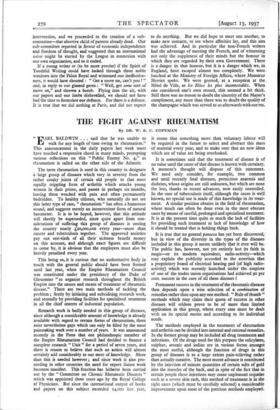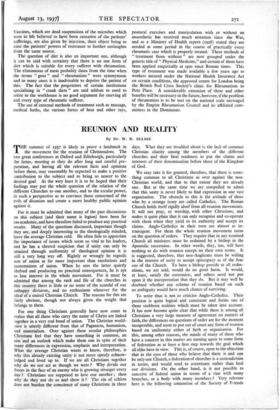THE FIGHT AGAINST RHEUMATISM
By DR. W. S. C. COPEMAN "EARL BALDWIN . . . said that he was unable to walk for any length of time owing to rheumatism." This announcement in the daily papers last week must have touched a responsive chord in many minds, prompting various reflections on this " Public Enemy No. 4," as rheumatism is called on the other side of the Atlantic.
The term rheumatism is used in this country to designate a large group of diseases which vary in severity from the rather creaky joints of certain old people to that most rapidly crippling form of arthritis which attacks young women in their prime, and passes in perhaps six months, leaving them wracked with pain and often permanently bedridden. To healthy citizens, who naturally do not see this latter type of case, " rheumatism" has often a humorous sound, and suggests merely an inconvenient form of natural barometer. It is to be hoped, however, that this attitude will shortly be superseded, since quite apart from con- siderations of suffering this group of diseases is costing the country nearly £20,000,000 every year—more than cancer and tuberculosis together. The approved societies pay out one-sixth of all their sickness benefit money on this account, and although exact figures are difficult to come by, it is obvious that the employers must also be heavily penalised every year.
This being so, it is curious that no authoritative body in touch with the general public should have been formed until last year, when the Empire Rheumatism Council was constituted under the presidency of the Duke of Gloucester " to organise research throughout the British Empire into the causes and means of treatment of rheumatic disease." There are two main methods of tackling the problem ; firstly by initiating and subsidising research work, and secondly by providing facilities for specialised treatment in all the chief centres of industrial population.
Research work is badly needed in this group of diseases, since although a considerable amount of knowledge is already available with regard to certain forms of rheumatism, there exist nevertheless gaps which can only be filled by the most painstaking work over a number of years. It was announced recently in the Press that one philanthropic member of the Empire Rheumatism Council had decided to finance a complete research " Unit " for a period of seven years, and there is reason to believe that such an action will almost certainly add considerably to our store of knowledge. More than this is needed however ; and since work is also pro- ceeding in other countries the need for expert liaison work becomes manifest This function has hitherto been carried out by the " Committee on Chronic Rheumatic Diseases " which was appointed three years ago by the Royal College of Physicians. But since the international output of books and papers on this subject exceeded 14,000 last year, it seems that something more than voluntary labour will be required in the future to select and abstract this mass of material every year, and to make sure that no new ideas which are of value are being overlooked.
It is sometimes said that the treatment of disease is of no value until the cause of that disease is known with certainty. A moment's thought will dispose of this statement. We need only consider, for example, two common and until recently fatal diseases, pernicious anaemia and diabetes, whose origins are still unknown, but which are none the less, thanks to recent advances, now easily controlled. In the case of tuberculosis itself, although the cause is well known, no special use is made of this knowledge in its treat- ment. A similar position obtains in the field of rheumatism, where much can often be done even in the most obscure cases by means of careful, prolonged and specialised treatment. It is at the present time quite as much the lack of facilities for providing such treatment as lack of knowledge of how it should be treated that is holding things back.
It is true that no general panacea has yet been discovered, but in view of the diversity in the types of the diseases included in this group it seems unlikely that it ever will be. The public has, however, not yet entirely lost its faith in magic—or its modern equivalent, radio-activity—which may explain the publicity accorded to the assertion that a proprietary brand of electrical heating pad (of high radio- activity) which was recently launched under the auspices of one of the trades union organisations had achieved 90 per cent. success in the cure of all these diseases I Permanent success in the treatment of the rheumatic diseases then depends upon a wise selection of a combination of remedies rather than upon any one method. " Rule of thumb " methods which may claim their quota of success in other diseases will seldom prove to be of more than limited application in this group, where every case must be dealt with on its special merits and according to its individual needs.
The methods employed in the treatment of rheumatism and arthritis can be divided into internal and external remedies. In the former group may be included all drug treatments and infections. Of the drugs used for this purpose the salicylates, sulphur, arsenic and iodine are in various forms amongst the most useful, although the function of drugs in this group of diseases is to a large extent pain-relieving rather than actually curative. The most recent advance is constituted by the injection of minute quantities of certain salts of gold into the muscles of the back, and in spite of the fact that in certain people these injections may cause unpleasant sequelae such as a severe skin rash, this method of treatment is in the right cases (which must be carefully selected) a considerable improvement upon most of the previous methods employed. Vaccines, which are dead suspensions of the microbes which were in life believed to have been causative of the patients' sufferings, are also given by injection, their object being to raise the patients' powers of resistance to further onslaughts from the same source.
The question of diet is also an important one, although it can be said with certainty that there is no one form of diet which is suitable for every sufferer with rheumatism. The elimination of meat probably dates from the time when the terms " gout " and " rheumatism " were synonymous and in many cases it is inadvisable to deprive the patient of this. The fact that the proprietors of certain institutions specialising in " crank diets " are said seldom to need to retire to the workhouse is no good argument for starving all and every type of rheumatic sufferer.
The use of external methods of treatment such as massage, medical baths, the various forms of heat and other rays, postural exercises and manipulation with or without an anaesthetic has received much attention since the War, and as a Ministry of Health report (1928) stated they are needed at some period in the course of practically every rheumatic case which is properly treated. These methods of " treatment from without " are now grouped under the generic title of " Physical Medicine," and certain of them have been applied empirically at spas since Roman times. This type of treatment was made available a few years ago to workers insured under the National Health Insurance Act on certain conditions, the approved centre for London being the British Red Cross Society's clinic for Rheumatism in Peto Place. A considerable extension of these and other benefits will be necessary in the future, however, if the problem of rheumatism is to be met on the national scale envisaged by the Empire Rheumatism Council and its affiliated com- mittees in the Dominions.







































 Previous page
Previous page